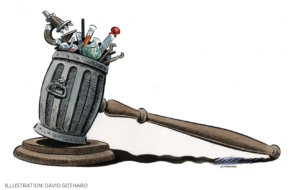
In-vitro fertilization (IVF) has become the latest political football. Democrats want to paint Republicans as opposed to this infertility procedure as part of their campaign for “women’s reproductive rights.” Now, former President Donald Trump is pushing back by saying he not only approves of IVF, but he wants the federal government, or your insurance company, to pay for it. In this atmosphere of hot political rhetoric, cooler heads must prevail.
The Wall Street Journal editorial board is generally conservative, but they oppose Trump’s proposal. Here’s what they say, “Donald Trump this week proposed subsidizing in-vitro fertilization treatments for all Americans, and the politics aren’t hard to discern. Mr. Trump is trying to blunt a GOP liability with women voters, particularly on abortion. But a new federal fertility entitlement is a fiscal and cultural thicket Republicans don’t want to enter.”
Most Americans know someone who has struggled to conceive children, and couples often turn to IVF procedures that cost tens of thousands of dollars from egg retrievals to embryo transfers. Insurers don’t always cover IVF, though companies appear to be expanding fertility benefits as more Americans form families at later ages. In 2022 some 43% of large employers covered IVF, up from 27% in 2020, according to one survey.
WSJ editors say, “The irony is that Mr. Trump is mimicking Barack Obama and his Affordable Care Act, which demanded that insurers offer the federal government’s preferred benefits regardless of expense. The cost of fertility procedures for some will be buried across higher premiums for everyone else. If Mr. Trump forces Affordable Care Act plans to cover IVF, he will encourage more Americans to move to taxpayer subsidized plans from small business offerings that often can’t afford to cover IVF.”
The editors are correct in saying this mimics the worst aspects of ObamaCare, the Affordable Care Act. Obama promised, “We’ll lower premiums by up to $2,500 for a typical family per year. . . . We’ll do it by the end of my first term.” (6/5/08). But premiums actually more than doubled. The main reason for the increase was the ACA mandated certain healthcare coverage in all policies – even prostate exams for women and mammograms for men. By mandating coverage not everyone needed, the price went up for everyone! The same thing would happen if Trump mandated IVF coverage for everyone.
WSJ goes on to explain the cost could run into the tens of billions annually, not least if Medicaid had to cover IVF, which it inevitably will if ObamaCare plans do. The government would dictate how many attempts are covered when an IVF cycle fails, and micromanage the quality of clinics. If you think IVF is expensive now, wait until it’s “free.”
It’s easy to understand why Trump is making this proposal this late in the election campaign. With Kamala Harris promising to continue the Biden Administration policies of college debt forgiveness, and pushing her own ideas of free healthcare for illegal immigrants, and even housing subsidies up to $25,000 for illegals, Trump feels like he’s in a bidding war for the American voter. Harris even promises a $6,000 tax credit for newborns!
But someone has to pay for all this government largess. We’re $35 trillion in debt now and that “someone” is the American taxpayer. If we don’t reign in the spending, the loser will be the defense budget and that’s just not acceptable in a world on the brink of WWIII.
IVF can be a wonderful solution to infertility problems, but let’s let couples make their own decision to attach such coverage to their health insurance. Trump’s proposal will only raise the cost of healthcare for everyone, including seniors like me who have no need for IVF.



